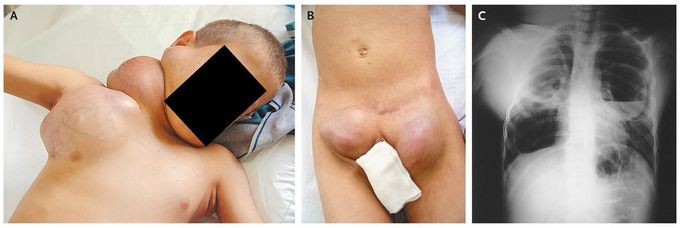


Chronic Granulomatous Disease
A 12-year-old boy was admitted to the hospital because of fever, chills, sweats, productive cough, nausea, and vomiting. He had been subject to recurrent pneumonias since the age of 5 years. On physical examination, he was febrile, tachycardic, and tachypneic; diffuse rhonchi were heard in both lungs. The patient also had finger clubbing, splenomegaly, and massive lymphadenopathy in the cervical, axillary, and preauricular areas (Panel A) and the epitrochlear and inguinal areas (Panel B) of his body. Blood cultures grew Staphylococcus aureus. A chest radiograph (Panel C) and computed tomography of the chest revealed multiple bilateral abscesses in both lungs. The results of a nitroblue tetrazolium reduction test and immunoblotting suggested a diagnosis of chronic granulomatous disease, which is characterized by recurrent life-threatening bacterial and fungal infections and granuloma formation. Most patients receive a diagnosis before reaching 5 years of age. This patient was treated with trimethoprim–sulfamethoxazole, levofloxacin, and voriconazole, with nearly complete resolution of symptoms. Lifelong prophylaxis with trimethoprim–sulfamethoxazole and itraconazole was recommended.
What are the symptoms of Wiskott-Aldrich syndrome? Nearly every child with Wiskott-Aldrich syndrome will start showing symptoms as a baby, between the time they're born and the time they turn 1. The symptoms usually include: frequent and easy bleeding that can occur: from the nose from the mouth and gums in bowel movements frequent and easy bruising a small red rash consisting of “dots” under the skin (these are called petechiae) chronic infections eczema (atopic dermatitis) autoimmunity (anemia, arthritis, inflammatory bowel disease, nephritis, vasculitis) Since Wiskott-Aldrich syndrome is a genetic disorder (caused by an error in the genes), it is always present at birth, however, symptoms may not show up until later in infancy. What causes Wiskott-Aldrich syndrome? Wiskott-Aldrich syndrome is a genetic disorder, meaning it is caused by a mutation, or error, in the child’s genes. Every living organism on this planet is made up of genes — tiny, complex coded instructions that determine what we look like, who we’re related to and how we’ll pass on our traits to our children (and our children’s children). Sometimes, the genes we inherit from a parent also contain mutations, or mistakes in the genetic code. When the mutation happens on the X chromosome — one of the two chromosomes, X and Y, that determine a person’s gender — it can be passed on by mothers to their sons. Because the mothers have two X chromosomes, even if they have a mutation on one of the two X chromosomes, they still have a normal copy of the gene on the other X chromosome, and therefore they themselves don’t experience any physical problems from the mutation. However they can transmit the X chromosome with the mutation — and the disease it causes — over to their male children. Boys have only one X chromosome, so male babies who inherit from their mother the faulty X chromosome with, will have the disease. Sometimes a boy can be born with the faulty X chromosome, even though his mother is not a carrier of the mutation (in this case, the mutation arises in the germ cell of the mother). Wiskott-Aldrich syndrome develops as the result of a defect in a gene located on the X chromosome. Because females have two X chromosomes, but males have only one, women who carry a defect of the Wiskott-Aldrich syndrome gene in one of their X chromosomes do not develop symptoms of the disease (because they have a “healthy” X chromosome), but can pass the defective gene on to their male children. As a result, Wiskott-Aldrich syndrome almost always affects boys only.

